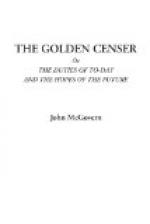IMITATE THE CELEBRATED DETECTIVES,
who actually pay little attention to things gross and palpable, but follow the more closely those minute clews which, interlacing and concentering, often as a whole, lead them, with the greatest certainty, to the dark hand that did the foul deed. Here is
A RIDICULOUS ERROR:
On Tuesday, the third of May, 1881, Scranton, Willard & Co., brokers, of New York City, sold to Decker & Co. stocks to the enormous sum of $127,000. For this property Decker & Co. wrote a check on a bank for $127,000, and a messenger was sent by the cashier of Scranton, Willard & Co., to have the check certified—that is, to have the bank officials write across the face of the check in red ink “Certified,” meaning that the money was there and would thenceforth be dedicated to the redemption of that particular piece of paper. The boy returned with the check, the cashier put upon his own file a “tag” representing the amount of money, along with many other similar records, and the boy was sent with the check to the Bank of North America. The boy handed to the banker, with the check, a similar “tag” from the cashier, which was also filed. When you deposit money, at many banks, you fill out a “tag” or deposit-check, and offer it with the money, which “tag” is used by the banker as a safeguard against errors and lapses of all kinds. When Scranton, Willard & Co.’s cashier reckoned up his “tags” he found no record of a check for $127,000. He immediately accused the boy of purloining the check, and inquiry at the bank (met by the reply that no such check had been deposited, as shown by the depositor’s own “tags”) strengthened his suspicions.
ALL THE BANKS OF NEW YORK
were at once notified of the loss of the great check, and costly engagements were made to advertise the matter all over the country. The boy was not arrested, but his case was not neglected, you may be assured. Repeated cross-questioning failed to shake his simple statement, that he had done as he had been told to do.
THE ACCOUNTS OF THE BANK OF NORTH AMERICA
were behind that afternoon, and the cashier stayed until late in the day to get them balanced. After he had finally secured the totals of the day’s transactions, he found that he had received, according to the depositors’ “tags,” $114,300 less than he had paid out. In some perturbation he recalled the notice of Scranton, Willard & Co., and at once sent to them, to see if that affair had anything to do with his immense discrepancy. Following this line of inquiry, Scranton, Willard & Co.’s cashier found that, in attempting to put the figures “127,000” on the “tag” of deposit he had neglected to write the last cipher, and the “tag” for $12,700 which had been made in its place, added to $114,300 which the banker lacked in “tags,” exactly made up the $127,000 which the bank had in reality credited to Scranton, Willard & Co.’s account. How could a man leave off




